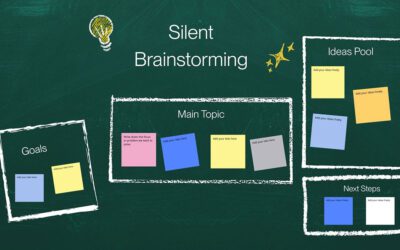In many modern offices, silence is not always a sign of calm. Sometimes, it can be a clear symptom of something deeper: workplace anxiety. When team members do not communicate, avoid speaking in meetings, or seem tense even during pauses, there may be an emotional discomfort that manifests subtly but persistently.
Detecting and addressing workplace anxiety early is key to building healthier, more humane, and resilient teams. It is important to identify these silent signals and understand how silence can become a powerful tool for containment and transformation.
What is workplace anxiety and how does it manifest daily?
Workplace anxiety refers to the constant stress associated with the work environment. It often manifests as excessive worry, difficulty concentrating, irritability, or mental fatigue. But it is not always visible.
Here are some common signs:
- Prolonged silence during meetings.
- Avoiding direct conversations with colleagues or leaders.
- Hypervigilance toward emails or messages.
- Isolation or emotional disconnection from the team.
- Changes in usual behavior: less participation, less creativity, more mistakes.
Why don’t we talk about workplace anxiety?
In many corporate environments, talking about emotions is still seen as a weakness. The pressure for productivity, fear of losing a job, or being perceived as “less capable” causes many people to experience workplace anxiety in silence.
Additionally, digital tools have accelerated work pace but also increased overload: constant notifications, back-to-back meetings, immediate responses. This creates a continuous feeling of being behind, feeding the discomfort.
Silence as a tool for emotional health
Although it may seem contradictory, silence, when voluntary and respectful, can be part of the solution.
How can silence help reduce workplace anxiety?
- Reduces sensory overload by creating spaces without stimuli, the brain recovers its focus capacity.
- Brief pauses without speaking help reduce reactivity to stress and foster emotional regulation
- Encourages active listening, instead of automatic responses, space is created to understand and better connect with the team.
- Activates introspection and allows employees to process what they feel without interruptions.
Recommended video:
How to Create a Culture of Psychological Safety | Amy Edmondson | TEDx
(This talks about creating a work environment where it’s safe to express yourself, crucial for addressing workplace anxiety.)
How to Manage Workplace Anxiety in a Team
Managing workplace anxiety within a team doesn’t mean eliminating tension entirely, something impossible in professional environments, but rather learning to recognize it, regulate it, and prevent it from becoming a chronic obstacle.
It involves creating safe communication channels where team members can express concerns without fear of repercussions, establishing active breaks to disconnect from the constant pace, and encouraging practices such as strategic silence in meetings, allowing ideas to be processed before responding.
Situations Related to Workplace Anxiety
Workplace anxiety is often linked to factors such as task overload, tight deadlines, lack of recognition, or constant organizational changes.
It can also appear in more subtle ways, through a corporate culture where hyperconnectivity is the norm or where internal competitiveness leaves little room for genuine collaboration.
These contexts affect not only performance but also team cohesion.
Symptoms and Warning Signs
Common signs that a team is experiencing workplace anxiety include an increase in mistakes due to distraction, higher rates of sick leave, meetings with little active participation, or excessively reactive communication.
Individually, symptoms may include sleep problems, constant irritability, or difficulty disconnecting after work hours.
Identifying these symptoms early is key to preventing anxiety from becoming ingrained in the team culture.
Practical Ways to Address It
Addressing workplace anxiety requires a combined approach: both individual and collective.
On a personal level, it can be helpful to incorporate micro-breaks throughout the day, such as brief breathing exercises or moments of mindful silence before a presentation.
At the team level, you can implement short meetings without technological interruptions, set realistic expectations, and publicly acknowledge achievements no matter how small.
The goal is to create an environment where pressure is not the default state.
How to implement moments of silence at work
It’s not about imposing silence, but integrating it as part of well-being. Here are some strategies:
- Start meetings with a minute of silence; it helps focus and regulate stress.
- Designate quiet zones: small corners where the team can retreat for a few minutes.
- Listening exercises without interruption; turns where one person speaks without being interrupted, and the rest listen actively in silence.
- Silence retreats or workshops: sessions focused on full presence without unnecessary noise.
If you want to explore how silence can transform urban and personal environments, check out our complementary article:
Silent refuges in the city: quiet places in Barcelona
Visible benefits for teams
Integrating moments of silence into the work culture not only helps mitigate workplace anxiety but also boosts benefits like:
- Greater team cohesion: shared pauses generate a sense of connection.
- Better decisions: a team that reflects rather than reacts automatically.
- Improved collective emotional health: less burnout, less friction, more clarity.

Recommended resources
- Why You Should Talk About Your Anxiety at Work – Adam Whybrew (TED)
- 3 Ways to Manage Moments of Work‑Induced Anxiety – Harvard Business Review
Towards a more conscious work culture
Facing workplace anxiety doesn’t always require big changes, but greater awareness. Incorporating moments of silence and active listening within the work environment can make a difference. Sometimes, the first step toward a more balanced team is not to talk more, but to know when to pause.
Follow us on Instagram to learn more about wellness and silence at work:
@silentfocus.co





